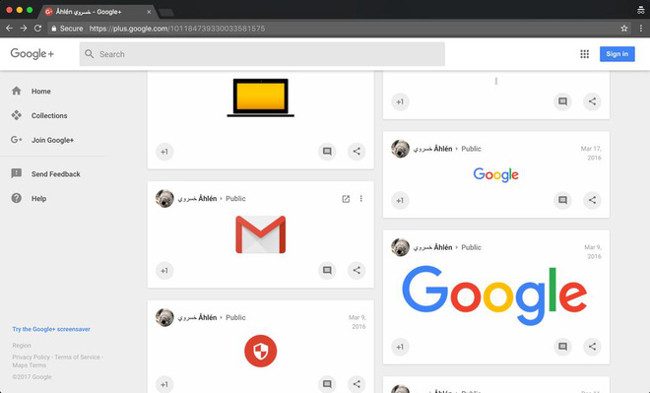Russian Hacker is using Google's own infrastructure to hack Gmail users
Security researchers have discovered a sophisticated hacking and fake news campaign targeting more than 200 Gmail accounts.
Hackers in Russia seem to have figured out a way to bypass Gmail's censorship engine to infiltrate user accounts thanks to Google's own services.
On Thursday, researchers found a spying and fake information campaign from Russia using sophisticatedly designed email to trick users into "giving" passwords to hackers without knowing it. It is a phishing technique targeting more than 200 victims, including journalists and political activists of the Russian government, as well as those with links to the Ukrainian army and senior officials in the companies. energy in the world.

The Citizaen Lab team at Munk School - University of Toronto has identified the number of victims based on traces in two phishing emails sent to David Satter, an American journalist and researcher.
On October 7, Satter received a design impersonation email that looked like from Google content support that someone had stolen an account password. In the letter suggested you need to change the security code by clicking on the link provided.
Just like the phishing attacks on Hillary Clinton's campaign led to the e-mail leak of the Democratic National Committee (DNC) last year, that email didn't come from Google. In fact, they are products of hackers called Fancy Bear or APT28 from Russia.

The "Change Password" button is associated with a shortened URL from the Tiny.cc service, a Bitly competitor. However, hackers cleverly designed landing pages into legitimate links using Google's AMP (Accelerated Mobile Pages page). This is a service to create lightweight and fast-loading websites that fit the search giant's mobile device. Notably, they were made a copy on Google's server and acted as a landing page redirect.

According to Citizen Lab experts, hackers use Google AMP to trick victims into believing it is an email from Google. John Scott-Railton, senior researcher at Citizen Lab, said: " It's a chance game, you can't catch every fish targeted, but there is still a certain percentage of traps ."
If you move the mouse pointer over the link to test, the victim will see a URL in the form of Google.com/amp that looks very safe followed by the short form of Tiny.cc. For example: https://www.google.com/amp/tiny.cc/abcd.

The trick to using Google's redirection service can bypass Gmail's filter. And yet, Citizen Lab also found the shortened address as Tiny.cc pointing to Google Plus page containing a security warning image that looks like Gmail. Chances are, hackers use to embed phishing emails to avoid Google's control.
Users should be wary of strange email or check the email address carefully to avoid being cheated. Recently, WannaCry "pandemic" also partially infects the way the link comes in the mail. It becomes an expensive lesson for those who lack vigilance in protecting themselves.
According to Genk
You should read it
- Instructions for adding email accounts to Gmail on iPhone, iPad
- Microsoft admits hackers may have read Outlook email and warned users to change their passwords
- How to identify phishing emails
- Leave Gmail as the default mailbox for many email addresses
- How to add and delete Email accounts on Mac, iPhone and iPad
- Top 10 most dangerous malware types with bank accounts
- Appears new malware specializing in stealing Steam, Epic Games and EA Origin accounts
- Instructions for setting up Windows send email notifications every time you log in
May be interested
- The corner of getting rich: A company hung a $ 1 million prize for anyone who hacked WhatsApp and iMessage
 if you are a hacker or a security researcher, have a profound knowledge about the iphone, what are you waiting for without trying, maybe a warm new year!
if you are a hacker or a security researcher, have a profound knowledge about the iphone, what are you waiting for without trying, maybe a warm new year! - Notorious hacker group Hafnium deployed malicious code to target Windows, Microsoft stood still
 hafnium, the notorious hacker group that shocked the world with a campaign to destroy microsoft exchange servers more than a year ago, is making a comeback that makes microsoft once again stand still.
hafnium, the notorious hacker group that shocked the world with a campaign to destroy microsoft exchange servers more than a year ago, is making a comeback that makes microsoft once again stand still. - An online dating application hacked, 3.6 million users affected
 the relatively detailed personal information of 3,688,060 users of the popular online dating app mobifriends has been publicly posted by the hacker and is now available for download.
the relatively detailed personal information of 3,688,060 users of the popular online dating app mobifriends has been publicly posted by the hacker and is now available for download. - Hackers claim how good it is to hack Mark Zuckerberg's Facebook account?
 chang chiu graduated from taiwan national university and made money by exploiting programming and security errors from many technology corporations to receive bonuses.
chang chiu graduated from taiwan national university and made money by exploiting programming and security errors from many technology corporations to receive bonuses. - How to Hack a Database
 the best way to make sure your database is safe from hackers is to think like a hacker. if you were a hacker, what kind of information would you look for? what will you do to get that information? there are many diverse methods to hack different types of databases, but most hackers will try to crack high-level passwords or execute database attacks. if you are familiar with sql commands and understand basic programming languages, you can try hacking a database.
the best way to make sure your database is safe from hackers is to think like a hacker. if you were a hacker, what kind of information would you look for? what will you do to get that information? there are many diverse methods to hack different types of databases, but most hackers will try to crack high-level passwords or execute database attacks. if you are familiar with sql commands and understand basic programming languages, you can try hacking a database. - Appearing software to help hack iCloud easier
 russian company phone breaker software elcomsoft can help hackers quickly steal data that you store on icloud by allowing hackers to quickly select the files they want to steal instead of having to download all the data that could be lost. many hours.
russian company phone breaker software elcomsoft can help hackers quickly steal data that you store on icloud by allowing hackers to quickly select the files they want to steal instead of having to download all the data that could be lost. many hours. - Apple announced a new, more diverse level of security bug detection bonus
 apple has just announced a new security bug detection money reward program, raising the reward level to $ 1 million.
apple has just announced a new security bug detection money reward program, raising the reward level to $ 1 million. - How to change Gmail password on computer
 when you change your gmail password with more characters, your email account will increase your security, avoiding having to hack your gmail account.
when you change your gmail password with more characters, your email account will increase your security, avoiding having to hack your gmail account. - The world's hottest 'hackers' go to court
 a russian schoolgirl was given the nickname 'the world's hottest hacker' after participating in an online scam to steal $ 35 million.
a russian schoolgirl was given the nickname 'the world's hottest hacker' after participating in an online scam to steal $ 35 million. - 17 skills needed to become a hacker
 to become a professional hacker you need a lot of knowledge in both engineering and information technology. here are 17 skills you will need to have if you want to be a good hacker.
to become a professional hacker you need a lot of knowledge in both engineering and information technology. here are 17 skills you will need to have if you want to be a good hacker.










 20 tips for new Chromebook users should know
20 tips for new Chromebook users should know 10 key points at Google I / O 2017
10 key points at Google I / O 2017 See when Google brings Android and virtual assistants to what cars will look like
See when Google brings Android and virtual assistants to what cars will look like Download the latest Joomla version to fix a serious SQL Injection vulnerability
Download the latest Joomla version to fix a serious SQL Injection vulnerability 5 reasons why Windows 10 S lags far behind Chrome OS
5 reasons why Windows 10 S lags far behind Chrome OS Not only Netflix, other App Developers can also block Android from being rooted to download applications
Not only Netflix, other App Developers can also block Android from being rooted to download applications